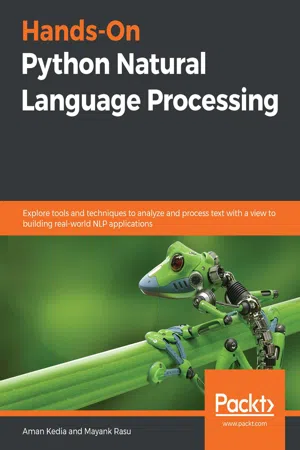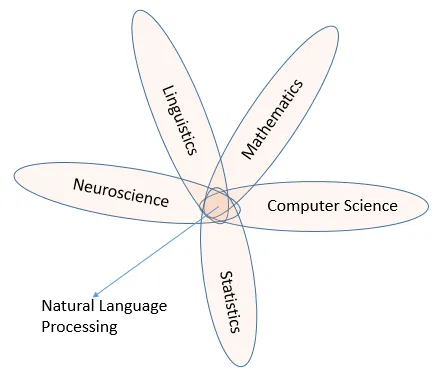
Hands-On Python Natural Language Processing
Explore tools and techniques to analyze and process text with a view to building real-world NLP applications
- 316 pages
- English
- ePUB (mobile friendly)
- Available on iOS & Android
Hands-On Python Natural Language Processing
Explore tools and techniques to analyze and process text with a view to building real-world NLP applications
About this book
Get well-versed with traditional as well as modern natural language processing concepts and techniques
Key Features
- Perform various NLP tasks to build linguistic applications using Python libraries
- Understand, analyze, and generate text to provide accurate results
- Interpret human language using various NLP concepts, methodologies, and tools
Book Description
Natural Language Processing (NLP) is the subfield in computational linguistics that enables computers to understand, process, and analyze text. This book caters to the unmet demand for hands-on training of NLP concepts and provides exposure to real-world applications along with a solid theoretical grounding.
This book starts by introducing you to the field of NLP and its applications, along with the modern Python libraries that you'll use to build your NLP-powered apps. With the help of practical examples, you'll learn how to build reasonably sophisticated NLP applications, and cover various methodologies and challenges in deploying NLP applications in the real world. You'll cover key NLP tasks such as text classification, semantic embedding, sentiment analysis, machine translation, and developing a chatbot using machine learning and deep learning techniques. The book will also help you discover how machine learning techniques play a vital role in making your linguistic apps smart. Every chapter is accompanied by examples of real-world applications to help you build impressive NLP applications of your own.
By the end of this NLP book, you'll be able to work with language data, use machine learning to identify patterns in text, and get acquainted with the advancements in NLP.
What you will learn
- Understand how NLP powers modern applications
- Explore key NLP techniques to build your natural language vocabulary
- Transform text data into mathematical data structures and learn how to improve text mining models
- Discover how various neural network architectures work with natural language data
- Get the hang of building sophisticated text processing models using machine learning and deep learning
- Check out state-of-the-art architectures that have revolutionized research in the NLP domain
Who this book is for
This NLP Python book is for anyone looking to learn NLP's theoretical and practical aspects alike. It starts with the basics and gradually covers advanced concepts to make it easy to follow for readers with varying levels of NLP proficiency. This comprehensive guide will help you develop a thorough understanding of the NLP methodologies for building linguistic applications; however, working knowledge of Python programming language and high school level mathematics is expected.
Frequently asked questions
- Essential is ideal for learners and professionals who enjoy exploring a wide range of subjects. Access the Essential Library with 800,000+ trusted titles and best-sellers across business, personal growth, and the humanities. Includes unlimited reading time and Standard Read Aloud voice.
- Complete: Perfect for advanced learners and researchers needing full, unrestricted access. Unlock 1.4M+ books across hundreds of subjects, including academic and specialized titles. The Complete Plan also includes advanced features like Premium Read Aloud and Research Assistant.
Please note we cannot support devices running on iOS 13 and Android 7 or earlier. Learn more about using the app.
Information
- Chapter 1, Understanding the Basics of NLP
- Chapter 2, NLP Using Python
- Programming languages versus natural languages
- Why should I learn NLP?
- Current applications of NLP
Programming languages versus natural languages
Understanding NLP

- ML algorithms (Naive Bayes; Support Vector Machine (SVM))
- DL algorithms (Convolutional Neural Network (CNN); Recurrent Neural Network (RNN))
- Similarity/dissimilarity measures
- Long Short-Term Memory (LSTM) network; Gated Recurrent Unit (GRU)
- BERT
- Building chatbots; sentiment analyzer
- Predictive analytics on text data
- Machine translation system
Why should I learn NLP?
- Luminance: Legal tech start-up aimed at analyzing legal documents
- NetBase: Real-time social media feed analytics
- Agolo: Summarizes large bodies of text at scale
- Idibon: Converts unstructured data to structured data
Current applications of NLP
Table of contents
- Title Page
- Copyright and Credits
- About Packt
- Contributors
- Preface
- Section 1: Introduction
- Understanding the Basics of NLP
- NLP Using Python
- Section 2: Natural Language Representation and Mathematics
- Building Your NLP Vocabulary
- Transforming Text into Data Structures
- Word Embeddings and Distance Measurements for Text
- Exploring Sentence-, Document-, and Character-Level Embeddings
- Section 3: NLP and Learning
- Identifying Patterns in Text Using Machine Learning
- From Human Neurons to Artificial Neurons for Understanding Text
- Applying Convolutions to Text
- Capturing Temporal Relationships in Text
- State of the Art in NLP
- Other Books You May Enjoy